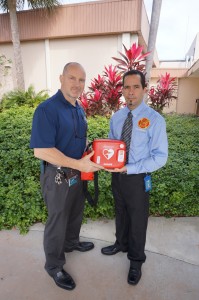NSU Newsroom
SharkBytes
Horizons
This version of NSU News has been archived as of February 28, 2019. To search through archived articles, visit nova.edu/search. To access the new version of NSU News, visit news.nova.edu.
This version of SharkBytes has been archived as of February 28, 2019. To search through archived articles, visit nova.edu/search. To access the new version of SharkBytes, visit sharkbytes.nova.edu.
Pride Bite: The Power of Preparation – NSU’s Hometown Heroes Save a Life
We buy insurance, hoping we will never need it. Sometimes, however, life pushes us to use the cushion we have prepared. That kind of unforeseen moment occurred on January 26, when two Nova Southeastern University colleagues in Physical Plant—Anthony Iovino, B.S., assistant director, and Edgar Ruiz, M.I.B.A., manager of fire and life safety—used their lifesaving skills to rescue a coworker.
A male coworker started the workday at 7:45 a.m. when he suddenly collapsed, and Iovino rushed over to find out what had happened. “Initially, I thought he was having a seizure, so I placed him on his side in case he started to vomit,” he said. “It didn’t look like he was breathing, so I called out immediately to others in the office to call 911.”
Ruiz arrived and saw the coworker shaking on the floor. Within seconds, he had lost consciousness and started turning blue.
Leaving Ruiz with the unconscious coworker, Iovino ran down the hall to retrieve the automatic external defibrillator (AED)—a portable device designed to respond to a cardiac emergency by analyzing the heart rhythm and delivering an electrical shock, if needed. AEDs have been installed in many areas throughout NSU and can increase the chance for lifesaving defibrillation.
Iovino and Ruiz immediately administered CPR, before attaching the AED, which conducted an analysis and advised that a shock was needed. “I cleared the area around our coworker on the floor, making sure no one was touching him, placed the pads, and shouted ‘Clear!’ before pressing the shock button,” Ruiz said.
After the first shock, there was no response, so Ruiz and Iovino continued CPR. “The second round of CPR succeeded and he suddenly woke up, sat up, and was breathing and coherent. Within minutes, EMS arrived and took over the next phase of care,” Iovino said.
The patient was transported to the hospital, where doctors diagnosed ventricular fibrillation and implanted a pacemaker in his chest. Two days later, the coworker left the hospital and went home.
Both Iovino and Ruiz have years of experience in lifesaving techniques and completed their latest training course on campus in December 2015. The American Heart Association’s Heartsaver CPR/AED training is offered by the College of Osteopathic Medicine’s Department of Emergency Medical Service Education and Training and provides lifesaving classes to faculty and staff members as well as students. The training is also offered to the larger community of businesses, schools, medical offices, and others.
Ruiz said, “Many times, employees don’t take CPR/AED training seriously, but we are living proof the course offered through NSU’s College of Osteopathic Medicine was crucial in saving a life.”
